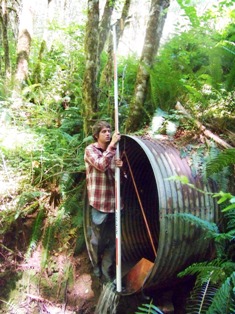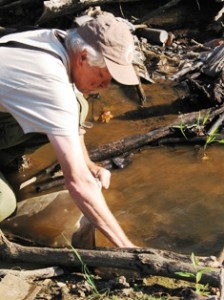
culverts in the summer of 2009 to help us
understand where culverts pose barriers
to fish migration.
LTWC is a local leader in surveying habitat conditions, fish passage barriers, trout migration, and more. Data LTWC collects has informed key organizational documents like our Watershed Assessment and Conservation Strategy. Our data is also helping others in the local scientific community understand current conditions and trends in watershed, such as ODFW and the Oregon DEQ.
Fish Barrier Inventory
For instance, during the summer of 2009, LTWC surveyed nearly 300 culverts in the watershed, assessing which ones are barriers to native fish. We’re using this information to prioritize areas that have the have the potential to do the most good for fish like cutthroat trout. When trout are faced with barriers such as undersized culverts, they are unable to access spawning habitat or the cold water refuges of higher elevation stream reaches during the summer.
Macroinvertebrate Survey

macroinvertebrates, which are
indicators of overall stream health.
Macroinvertebrates include crayfish, clams, snails, aquatic worms, and the laval stage of dragonflies and caddisflies. These organisms are used as an indicator of overall stream health because they exist in all types of streams, are not afflected by physical barriers, and are an important food source for fish and wildlife. Fewer macroinvertebrates indicate a lower overall health of the stream ecosystem.
Rapid Bio-Assessment
The rapid bio-assessment uses a technique where the surveyor snorkels stream pools to inventory the relative presence and abundance of fish such as cutthroat trout. We particularly use this survey to find out information about how and where cutthroat trout are utilizing streams during the summer and where habitat quality could be improved.
Stream Habitat Surveys
During the summer, we also monitor habitat conditions along stream reaches where we have either done a restoration project or plan to do so. This data primarily looks at measuring stream habitat complexity and the streamside vegetation condition. Habitat complexity measures the variation in stream depth and the types of habitats, such as pools and riffles. With streamside vegetation, we’re measuring how well the stream is shaded by canopy cover as well and also characterizing the structure and diversity of riparian plants.
